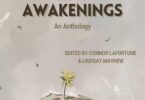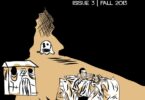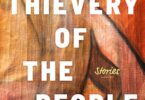Reviewed by James K. Moran
Hannah Templer, Cosmoknights (Book One) (Top Shelf Productions, 2019), 216 pp., $25.99, and
Cosmoknights (Book Two) (Top Shelf Productions, 2023), 280 pp., $33.99.
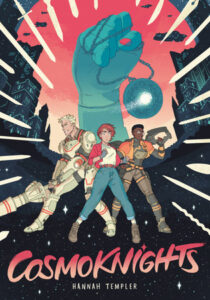 Readers will find Hannah Templer’s Cosmoknights a delightfully colourful queer space opera and heartfelt lesbian sci-fi adventure. Manga-influenced, it is equally concerned with jousting matches, a motley crew of LGBTQ2S+ characters overthrowing the patriarchy, finding family and rounding out its characters.
Readers will find Hannah Templer’s Cosmoknights a delightfully colourful queer space opera and heartfelt lesbian sci-fi adventure. Manga-influenced, it is equally concerned with jousting matches, a motley crew of LGBTQ2S+ characters overthrowing the patriarchy, finding family and rounding out its characters.
In 2164, not-so-subtly named Pandora (“Pan”) Leverett, from a working-class family, has grown up with her bestie Tara, who is from a noble line. Their sleepy town of Greenvale, on the planet Viridian, soon hosts the latest interplanetary jousting games, a medieval-style tournament pitting armoured cosmoknights in a battle royale. In this literal patriarchal game, Cosmoknights’ raison d’être, the winner gets knighted, claims a princess, and marries into the patriarchy.
On the eve of Tara being offered as a prize, she rebels, not wanting to be married off, but to live her own life. She enlists Pan’s help to get her aboard an automated cargo ship so Tara can flee. Five years later, in 2169, with the tournament on again, the locket Tara left her remains a painful reminder to Pan of their separation. When injured cosmoknight, the charismatic Cass, and her wife, Bee, seek secret medical help from Pan’s mother, a doctor, and father, a mechanic, Pan sees a chance to get off-planet and pursue the person who could be more than her closest friend.
Pan enters the world of the capitalist-and-hierarchy-driven jousting tournaments, encountering many strong, butch, delightful female characters. It’s Star Wars, but without Admiral Leia Organa reduced to a bit role, or if Rey Skywalker had an all-star female supporting cast. A bro’s nightmare rollcall of capable female doctors, mechanics, pirates, rebels, rogues, scrappers and princesses occupies the panels.
Remarkable comic-book industry talent Hannah Templer does it all—writing, colouring, penciling, and laying out Cosmoknights, which was originally a webcomic. The New York Times and National Public Radio first took note of Templer penciling Flung Out of Space: Inspired by the Indecent Adventures of Patricia Highsmith (Abrams), written by Grace Ellis. A fictionalized account of Highsmith’s writing career, Flung depicts inspirations for her 1952 lesbian love novel The Price of Salt, which was later adapted into the lauded 2015 historical romance film Carol. Many reviewers dubbed Flung one of 2022’s best LGBTQ2S+ graphic novels. Plenitude reviewer Trevor James McNeil covered it in a double review with Greg Lockard and Tim Fish’s Liebestrasse (Dark Horse Comics). I highly recommend both.
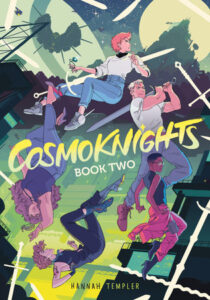 Cosmoknights having started online might explain the first trade’s off-beat, often languid pace. There’s certainly no rush to initially venture off-world, with pauses in Pan, Cass and Bee’s conversations likely longer than intended. Still, Templer inhabits the panels with vibrance—gorgeous orange, lavender, teal, pink, blue, and indigo. She keys into the small-town vibe with brilliant sunsets and skyscapes. The mise-en-scène fascinatingly contrasts sleepy, small-town atmosphere with high-sci-fi tech. This, along with Pan and Tara’s rapport, does the heavy lifting of worldbuilding. From page one, readers feel Pan’s desire to see the stars. By page 72, when Pan muses about those stars, they are wonderfully reflected in her blue eyes.
Cosmoknights having started online might explain the first trade’s off-beat, often languid pace. There’s certainly no rush to initially venture off-world, with pauses in Pan, Cass and Bee’s conversations likely longer than intended. Still, Templer inhabits the panels with vibrance—gorgeous orange, lavender, teal, pink, blue, and indigo. She keys into the small-town vibe with brilliant sunsets and skyscapes. The mise-en-scène fascinatingly contrasts sleepy, small-town atmosphere with high-sci-fi tech. This, along with Pan and Tara’s rapport, does the heavy lifting of worldbuilding. From page one, readers feel Pan’s desire to see the stars. By page 72, when Pan muses about those stars, they are wonderfully reflected in her blue eyes.
Just as Luke Skywalker longed to leave Tatooine, Pan longs to leave Viridian to find Tara. You can almost hear Journey’s “Don’t Stop Believin’” while she bicycles through quiet, dusky streets as you flip the pages, a small-town gal livin’ in a lonely world. However, above the small-town lights hovers a fantastical skyscape populated by unfamiliar planets and stars.
Pan gets swept up in the plans of tournament competitor Cass (former Princess Cassar Gail)—everyone’s crush, sort of a muscled-up Erroll Flynn matinée idol type—and her wife, pilot Bee or Brigitte. They are rebels fighting the patriarchy with a tried-and-true racket. When Cass wins a tournament, she and Bee secretly free the princess involved from the arranged marriage and a life of patriarchal servitude, offering them an independent life off the grid.
From the outset, the book’s rural vibe skillfully contrasts with the loud, large mechanized cosmoknight games, the bombastic fight scenes inspired by Manga.
Templer runs amok with Manga influence, to the reader’s delight. Her sound effects are off the charts. Surroundings often obfuscate sound effects, to show many things happening simultaneously, adding depth to the panels. At a tournament, rowdy spectators raise their fists, cluttering their own ROAR. The rafters in the bustling kitchen of a high-end restaurant partially cover up the SSSSSS or CLANG or CHOP CHOP CHOP or CLINK of kitchen staff. The effects are admittedly cute. Other smaller flourishes also woo readers. When Pan observes something, miniscule ellipses appear beside her alert eyes. If she blushes, the reader knows from the little pink strokes on her cheekbones.
Templer knows her ways around panels. She’s unafraid to throw everything in, playing with combinations like five-to-eight-panel pages and double-or-single-splash-page spreads during dramatic moments, such as Pan saying, “I’m not going home,” on page 82 or bellowing, her red hair askew, “GET ON!!!” while seated on a hot-wired speeder on page 109.
Trade one, in slow yet great storytelling, showcases what Templer can do, with charming characters the reader can invest in, and skillful artistry. Its ship truly launches in the third act, with some resolution and a fine cliffhanger rivalling that of The Empire Strikes Back.
Trade two brings the found-family theme to the fore with new characters, including mysterious tattooed hacktivist Kate introduced in the last arc, Princess Scottie, and Percy, an unreasonably cute alien space cat. All the characters are beautiful in different ways. Cass remains a bold, butch, buff crush-inducer. Liberated Princess Scottie, a woman of size, resembles Jazmine St. Cocaine, the ex-pornstar character from Matt Fraction and Chip Zdarsky’s infamously amusing Sex Criminals Image Comics series.
Templer reclaims and refurbishes particular iconic sci-fi pop culture scenes. The more comical tone in Book Two perhaps owes much to vehicles such as the 2018 Netflix series She-Ra: Princess of Power. And a delightful space chase through an asteroid field tosses the characters about comically, likely a wink to The Empire Strikes Back’s asteroid-belt chase scene.
The characters, even minor, grapple with unexpected and initially unwanted found family, Templer adding welcome, surprising depth. Princess Scottie questions where her place is, if not among royalty. Cass and Bee must face their evolving marriage, having been on the run “temporarily” as space pirates for over ten years. The plucky Pan, happy to share her gift for mechanics, slowly realizes she may never see Tara again.
The crew argue over their next move to fight the system in expositional scenes that nearly subsume the story’s momentum before the climax. Kate tidily summates the oft-mentioned hierarchy and how the few three-per-centers perpetuate interplanetary poverty:
You’re saving a few princesses, but what about the rest of us?
We work our butts off for crumbs while they eat cake. We’re in factories while they recline in luxury.
And most of us get so fucked up from hard labor we end up on the streets with nothing.
We suffer so the gentry can profit, and their petty tournament keeps it all in the family.
Templer fleshes out Pan and Tara’s childhood and working-class/nobility dichotomy in scenes rendered in the style of comics aimed at younger children. Pan calls on Tara playing in a pastoral setting, her parents’ castle the background. They gab about the jousting tournaments, kids discussing a game. They ultimately eschew pretending at patriarchy for adventuring with a DIY carboard-box spaceship Pan has built, placed on Tara’s hoverboard (it’s the future, after all). Smart storytelling, that, planting their bond, and the seeds for Pan’s starry-eyed idealism and Tara’s rebellious nature.
The comics creator continually underscores the theme of overthrowing the patriarchy, including with Cass’s considerable backstory, cementing her athletic rebelliousness. She did not want to be a princess, and she wants to save other young women from an arranged-marriage fate.
Expanding her palette, Templer becomes emboldened in Book Two. More emeralds, peacock blues and sunset oranges suffuse the panels. A two-page splash on pages 150 and 151 displays Ironvein, the mining planet that is the venue for an impending jousting confrontation, with the characters lined up, driving home the found-family theme. Templer’s unabashed use of phallus imagery continues, although sometimes jousting spears, protruding speeder bikes, and raw-power blasts from starship engines may simply be what they appear.
While some readers have called Cosmoknights “lesbians in space!,” that’s admittedly reductionist. Templer employs female characters in ways much pop culture space opera does not (I’m looking at you, Star Wars franchise). Her openly lesbian characters explore strange, new worlds. They harbour queer crushes, and dreams and desires that they question.
As physical media, each trade is of size, with slick, colour pages on well-bound, thick paper stock. Book One is 216 pages. The follow-up, 280. And Cosmoknights is worth your money.
Pan’s superpowers, ultimately, are empathy, and love, which she employs to resolve violent conflicts in surprising ways. With Templer’s luscious art, winsome script, and compelling characters, you can launch your own escape pod into some worthwhile lesbian space opera and fight the patriarchy.
 James K. Moran’s speculative fiction and poetry have appeared in Burly Tales: Finally Fairy Tales for the Hirsute and Hefty Gay Man, Bywords, Glitterwolf, On Spec, and elsewhere. His short-fiction collection Fear Itself, resplendent with queer characters, and his small-town Canada horror novel Town & Train featuring bi protagonist Constable David Forester, were published by Lethe Press. Moran freelanced for Xtra (née Capital Xtra! in 1993) for over 15 years. Find him at jameskmoran.blogspot.ca and reviewing for Arc Poetry Magazine and Strange Horizons. Also at @jamestheballadeer.bsky.social Bluesky, jamestheballadeer Instagram, and @jkmoran X/Twitter. Moran lives in Ottawa, on the unceded territory of the Anishinaabe Algonquin Nation.
James K. Moran’s speculative fiction and poetry have appeared in Burly Tales: Finally Fairy Tales for the Hirsute and Hefty Gay Man, Bywords, Glitterwolf, On Spec, and elsewhere. His short-fiction collection Fear Itself, resplendent with queer characters, and his small-town Canada horror novel Town & Train featuring bi protagonist Constable David Forester, were published by Lethe Press. Moran freelanced for Xtra (née Capital Xtra! in 1993) for over 15 years. Find him at jameskmoran.blogspot.ca and reviewing for Arc Poetry Magazine and Strange Horizons. Also at @jamestheballadeer.bsky.social Bluesky, jamestheballadeer Instagram, and @jkmoran X/Twitter. Moran lives in Ottawa, on the unceded territory of the Anishinaabe Algonquin Nation.


